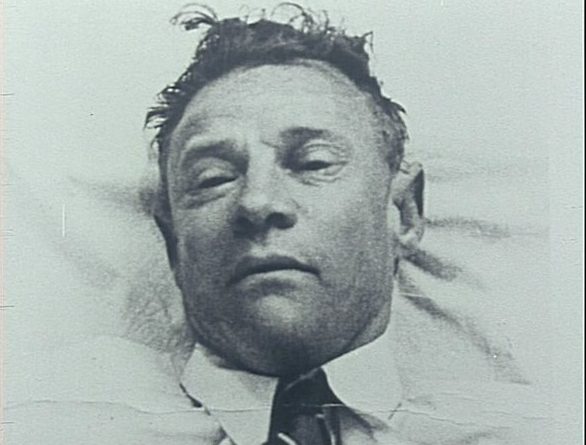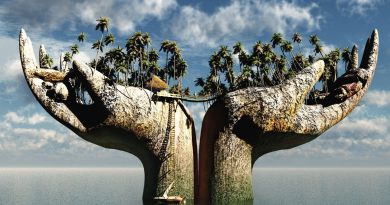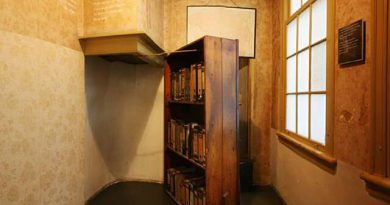Taman Shud Case – The Body on Somerton Beach
In 1948 the body of a man was found on Somerton beach in Adelaide, Australia. The man was never identified. Police found a suitcase which they believed was his containing clothing in which all but three items had their name tags removed. The name on the remaining items pointed them to a man who was later identified as not being the dead man. A small note in the mans pocket said taman shud which is the last line of the Rubaiyat of Omar Khayyam. It had been cut from a book. A doctor seeing the note on the TV contacted police to say that the book had appeared in the backseat of his unlocked car. It was the copy that had had the note removed. In the back of the book were coded markings which have not been able to be deciphered as yet:
MRGOABABD
MTBIMPANETP
MLIABOAIAQC
ITTMTSAMSTGAB
A name in the front of the book led police to a woman who said she had given it to a man named Boxall during the Second World War. Upon seeing a plaster cast of the dead man she identified him as Boxall. This appeared to solve the mystery of who the man was, until Boxall was discovered alive with his copy of the book undamaged. Coincidentally the woman who identified the man lived in Glenelg the last town visited by the dead man before he travelled by bus to his final destination. The woman asked police not to record her name as she was married and wanted to avoid scandal they foolishly complied and her identity is now also unknown. This is considered to be one of Australias most profound mysteries. Wikipedia has extensive information on this fascinating case here.
Most murders arent that difficult to solve. The husband did it. The wife did it. The boyfriend did it, or the ex-boyfriend did. The crimes fit a pattern, the motives are generally clear.
Of course, there are always a handful of cases that dont fit the template, where the killer is a stranger or the reason for the killing is bizarre. Its fair to say, however, that nowadays the authorities usually have something to go on. Thanks in part to advances such as DNA technology, the police are seldom baffled anymore.
They certainly were baffled, though, in Adelaide, the capital of South Australia, in December 1948. And the only thing that seems to have changed since then is that a story that began simplywith the discovery of a body on the beach on the first day of that southern summerhas bec0me ever more mysterious. In fact, this case (which remains, theoretically at least, an active investigation) is so opaque that we still do not know the victims identity, have no real idea what killed him, and cannot even be certain whether his death was murder or suicide.
What we can say is that the clues in the Somerton Beach mystery (or the enigma of the Unknown Man, as it is known Down Under) add up to one of the worlds most perplexing cold cases. It may be the most mysterious of them all.
Lets start by sketching out the little that is known for certain. At 7 oclock on the warm evening of Tuesday, November 30, 1948, jeweler John Bain Lyons and his wife went for a stroll on Somerton Beach, a seaside resort a few miles south of Adelaide. As they walked toward Glenelg, they noticed a smartly dressed man lying on the sand, his head propped against a sea wall. He was lolling about 20 yards from them, legs outstretched, feet crossed. As the couple watched, the man extended his right arm upward, then let it fall back to the ground. Lyons thought he might be making a drunken attempt to smoke a cigarette.
Half an hour later, another couple noticed the same man lying in the same position. Looking on him from above, the woman could see that he was immaculately dressed in a suit, with smart new shoes polished to a mirror shineodd clothing for the beach. He was motionless, his left arm splayed out on the sand. The couple decided that he was simply asleep, his face surrounded by mosquitoes. He must be dead to the world not to notice them, the boyfriend joked.
It was not until next morning that it became obvious that the man was not so much dead to the world as actually dead. John Lyons returned from a morning swim to find some people clustered at the seawall where he had seen his drunk the previous evening. Walking over, he saw a figure slumped in much the same position, head resting on the seawall, feet crossed. Now, though, the body was cold. There were no marks of any sort of violence. A half-smoked cigarette was lying on the mans collar, as though it had fallen from his mouth.
The body reached the Royal Adelaide Hospital three hours later. There Dr. John Barkley Bennett put the time of death at no earlier than 2 a.m., noted the likely cause of death as heart failure, and added that he suspected poisoning. The contents of the mans pockets were spread out on a table: tickets from Adelaide to the beach, a pack of chewing gum, some matches, two combs and a pack of Army Club cigarettes containing seven cigarettes of another, more expensive brand called Kensitas. There was no wallet and no cash, and no ID. None of the mans clothes bore any name tagsindeed, in all but one case the makers label had been carefully snipped away. One trouser pocket had been neatly repaired with an unusual variety of orange thread.
By the time a full autopsy was carried out a day later, the police had already exhausted their best leads as to the dead mans identity, and the results of the postmortem did little to enlighten them. It revealed that the corpses pupils were smaller than normal and unusual, that a dribble of spittle had run down the side of the mans mouth as he lay, and that he was probably unable to swallow it. His spleen, meanwhile, was strikingly large and firm, about three times normal size, and the liver was distended with congested blood.
In the mans stomach, pathologist John Dwyer found the remains of his last meala pastyand a further quantity of blood. That too suggested poisoning, though there was nothing to show that the poison had been in the food. Now the dead mans peculiar behavior on the beachslumping in a suit, raising and dropping his right armseemed less like drunkenness than it did a lethal dose of something taking slow effect. But repeated tests on both blood and organs by an expert chemist failed to reveal the faintest trace of a poison. I was astounded that he found nothing, Dwyer admitted at the inquest. In fact, no cause of death was found.
The body displayed other peculiarities. The dead mans calf muscles were high and very well developed; although in his late 40s, he had the legs of an athlete. His toes, meanwhile, were oddly wedge-shaped. One expert who gave evidence at the inquest noted:
I have not seen the tendency of calf muscle so pronounced as in this case . His feet were rather striking, suggestingthis is my own assumptionthat he had been in the habit of wearing high-heeled and pointed shoes.
Perhaps, another expert witness hazarded, the dead man had been a ballet dancer?
The mystery gets stranger after the jump.
All this left the Adelaide coroner, Thomas Cleland, with a real puzzle on his hands. The only practical solution, he was informed by an eminent professor, Sir Cedric Stanton Hicks, was that a very rare poison had been usedone that decomposed very early after death, leaving no trace. The only poisons capable of this were so dangerous and deadly that Hicks would not say their names aloud in open court. Instead, he passed Cleland a scrap of paper on which he had written the names of two possible candidates: digitalis and strophanthin. Hicks suspected the latter. Strophanthin is a rare glycoside derived from the seeds of some African plants. Historically, it was used by a little-known Somali tribe to poison arrows.
More baffled than ever now, the police continued their investigation. A full set of fingerprints was taken and circulated throughout Australiaand then throughout the English-speaking world. No one could identify them. People from all over Adelaide were escorted to the mortuary in the hope they could give the corpse a name. Some thought they knew the man from photos published in the newspapers, others were the distraught relatives of missing persons. Not one recognized the body.
By January 11, the South Australia police had investigated and dismissed pretty much every lead they had. The investigation was now widened in an attempt to locate any abandoned personal possessions, perhaps left luggage, that might suggest that the dead man had come from out of state. This meant checking every hotel, dry cleaner, lost property office and railway station for miles around. But it did produce results. On the 12th, detectives sent to the main railway station in Adelaide were shown a brown suitcase that had been deposited in the cloakroom there on November 30.
http://blogs.smithsonianmag.com/history/2011/08/the-body-on-somerton-beach/



